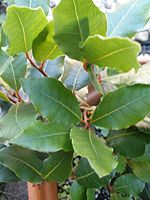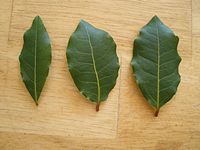What Is Bay Laurel
Bay laurel, sometimes referred to as sweetbay or sweet bay laurel, is an evergreen tree native to the region encompassing the Mediterranean and Turkey.
It is the source of the staple cooking herb ‘bay leaves’.
Although dried bay leaves are the most readily available form of seasoning from this evergreen tree, fresh fragrant bay leaves are one of my favourite herbs. They have a strong and complex aromatic scent that infuses almost any savory dish with its floral and spicy fragrance.
Fresh bay leaves are dark green, shiny and smooth with a brighter scent than their dried counterparts.
It is handy to grow your own bay tree for fresh leaves – just go outside and pick a couple of leaves for a recipe whenever you need it.
Latin name: Laurus nobilis
How To Grow The Bay Laurel Tree
Planting and growing a bay tree is fairly easy, and you will be rewarded with fresh bay leaves year round. And one bay tree is all you need for your kitchen herb garden.
Bay Laurel is a perennial tree, hardy in zones 8 through 10. Bay trees grow in full sun to partial shade, and like well-drained soil.
Planted outdoors in warm climates, the bay tree can grow anywhere from 10 feet high to 40 feet high. A potted bay laurel can grow up to about 5 feet.
Bay laurel flowers are not very noticeable – a creamy greenish yellow with no petals, forming purple fruits. Living in a cold climate, I have never seen my bay tree flower or bear fruit.
The sweet bay leaf plant is an attractive ornamental tree that can be grown as a landscape tree in warm climates.
The bay laurel tree is also an ideal container plant, and can be grown indoors as a houseplant.
In colder climates, grow your bay tree in a large container that can be brought indoors for the winter, and back outdoors in the summer. Bay trees overwinter indoors really well in a sunny window.
Occasionally, when you bring your bay laurel indoors, all the leaves will dry on it. Usually, I have found this will happen if the bay leaf plant is exposed to too much cold before being brought indoors.
If your bay leaves start drying on the plant, pluck off the dry leaves and store them for use in your recipes. Don’t throw out the tree though – new bay leaves will grow back on your tree.
Because it is an attractive tree, the bay leaf tree can also be incorporated with other planters for decorative patio gardens
Bay trees are easy to prune to suit your size needs. They can be cut back without harm. You can keep a bay tree small by clipping it regularly. Use your clipped bay leaves for cooking, or dry them for future use.
Bay trees can be started from seeds or cuttings.
Starting a Bay Laurel from seed: Seeds germinate at a temperature at about 75 degrees F within about 4 weeks. However, they tend to be difficult to start from seed. Seeds tend to turn moldy easily. Also, seeds that dry out in storage will not germinate.
Starting a Bay Laurel from cuttings: Cuttings taken from young green shoots in the spring are the most likely to root.
The easiest way to start a bay tree is to purchase a young plant from a nursery. Bay trees can grow for many years, so it’s definitely worth the investment in a tree.
Harvesting and Storing Sweet Bay Leaves
Harvesting Bay Leaves
Bay leaves can be harvested at any time throughout the year.
Pinch or snip off older leaves as you need them. When you prune your bay tree, dry the bay leaves from the branches you pruned off for use later.
Drying Bay Leaves
Bay leaves dry easily, and can be dried as they are harvested. Lay them out flat to dry on a surface with some air circulation. The bay leaves will dry within a few days. The colour of the bay leaves lightens as they dry.
If you want your bay leaves to stay flat during drying, place a board or some other type of light weight on the leaves, to keep them from curling as they dry.
Store dried bay leaves whole in a tightly sealed container once they’re dry.
Culinary Uses for Sweet Bay Leaves
Bay leaves are edible, and not poisonous. Because they are a tough, leathery leaf, whole bay leaves should be removed before serving your dish, to avoid someone choking on it. You can also grind up bay leaves for use in your recipes.
The leaves of the bay laurel are used in many cuisines around the world– bay leaves are prevalent throughout recipes from Europe, North America, the Middle East, and India (not to be confused with Indian bay leaf, which is related to cinnamon).
Bay leaves are a fundamental herb in French, Spanish and Creole soups, stews, marinades, and sauces.
Dried bay leaves are readily found in the spice section in supermarkets. By using your own fresh or dried bay leaves, you can be sure that you are using bay leaves that have not been sitting on a store shelf for an extended period of time.
Bay leaves are a staple herb addition to soup and stew recipes. Meat fish and poultry are complemented by the aroma and flavor of bay leaves.
And bay leaves are a must-have seasoning in crab and lobster boils.
Also add bay leaves to:
- Tomato saucePickling brines
- When cooking game meat
- Cooking water when cooking beans, lentils, rice or other grains
- Water when poaching fish
- Tuck bay leaves into chicken cavity before roasting
It’s hard to go wrong by adding a bay leaf or two to most savory dishes.
So, grow a bay tree, and enjoy its beauty in your garden, and flavor in your cooking.
To your herb gardening success,
Barb
Copyright © 2011 www.HerbGardenGal.com. All rights reserved.
_________
Want to use this article in your Ezine or Website? You can, as long as you include the complete article and the Copyright information.

